Is it still worth visiting Chiatura in Georgia if the cable cars aren’t operating?
Our two visits couldn’t have been more extreme, weather-wise. As a result, our post contains a mixture of sunny, summertime, photos and those taken in winter when the snow was thick on the ground!
In the past, most travellers to Chiatura had one thing on their agenda – taking a ride in the ancient Soviet-era cable cars that were first constructed under Stalin’s command to provide an easy form of transport for the town’s miners. But they are no longer running and it begs the question, is the Chiatura still worth visiting?
In short, the answer is a resounding YES and I’ll say why in due course but let me begin with a bit of background information and history about the town itself and the significance of the cable cars.
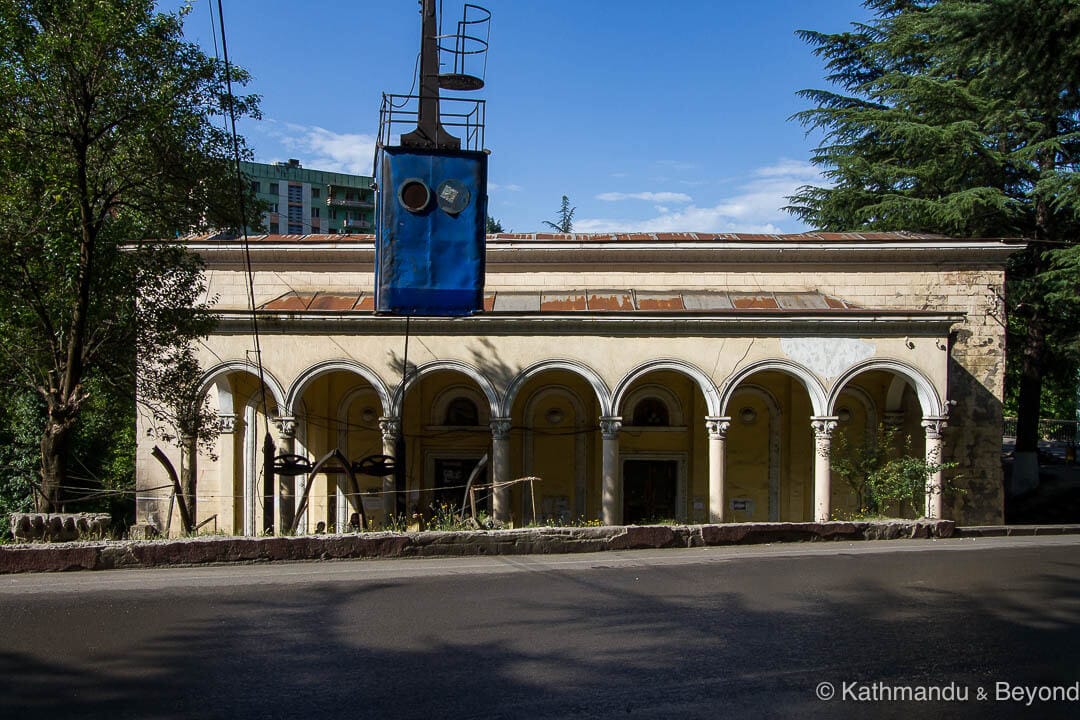
What you’ll find in this guide:
Places to see in Chiatura
Map of Chiatura
Riding Chiatura’s new cable cars
Soviet-era cable cars
Chiatura Railway Station
Temur Maghradze Stadium and swimming pool mosaic
Other Soviet mosaics in Chiatura
Soviet architecture in Chiatura
Monuments and memorials in Chiatura
Former Pioneer Palace
Chiatura Cross
Places to visit near Chiatura
Practical information
Where to stay in Chiatura
How to get to Chiatura
Chiatura as a day trip vs overnight stay
A short history of Chiatura
Chiatura is located in the Imereti region of Georgia. Tbilisi is 185kms to the southeast, while Kutaisi, the country’s third most populous city and a good base for exploring Chiatura, is 70kms or so to the west. Bordered by mountainous valleys and deep ravines, it was this precarious landscape that put Chiatura on the map when, in the late 1800s, the largest reserve of manganese in Georgia (and one of the greatest in the world) was discovered in the area.
The company set up by the state, JSC Chiaturmanganese, to handle the extraction of the manganese had no issues exporting the ore between Chiatura and Zestafoni where the parent ferroalloy (cleaning) plant was located. A rail link connecting the two towns was constructed as early as 1905. But where the company did lose valuable production time was with the transportation of the miners. For decades after the discovery, the workers would walk up and down the steep sides of the valleys to reach the mines. Having gazed down onto the town from one of the upper cable car stations, I can only imagine how tough it must have been to trudge up and down on foot. And to make things worse, once there, it was quite common for miners to work 18-hour shifts, sleeping in the shafts in the winter, and outside in the summer, and with no access to proper washing facilities.
The living and working conditions for the miners in Chiatura was very harsh and it is little surprise, therefore, that Joseph Stalin, who was Georgian by birth, was able to persuade the 3,500-plus workforce to back the Bolshevik cause during the Russian Revolution of 1905 (not to be confused with the more well-known one which took place in 1917). Over time, and with the assistance of the occasional strike and odd bit of thuggery, the miners’ conditions and pay did improve somewhat, although I’ve no doubt both were still pretty grim in comparison to other types of manual work.
The development of a cable car system connecting the mines with the town’s community didn’t happen until the mid-1950s. To improve man-management and increase productivity, the Soviet authorities installed a system of aerial tramways that not only operated up and down the almost-vertical slopes of the cliffs where the mines were located but also crisscrossed sections of the town itself. By 1954, the tramway system was fully operational and an infrastructure of seventeen lines was used by workers and residents alike to traverse the demanding terrain for many years thereafter.
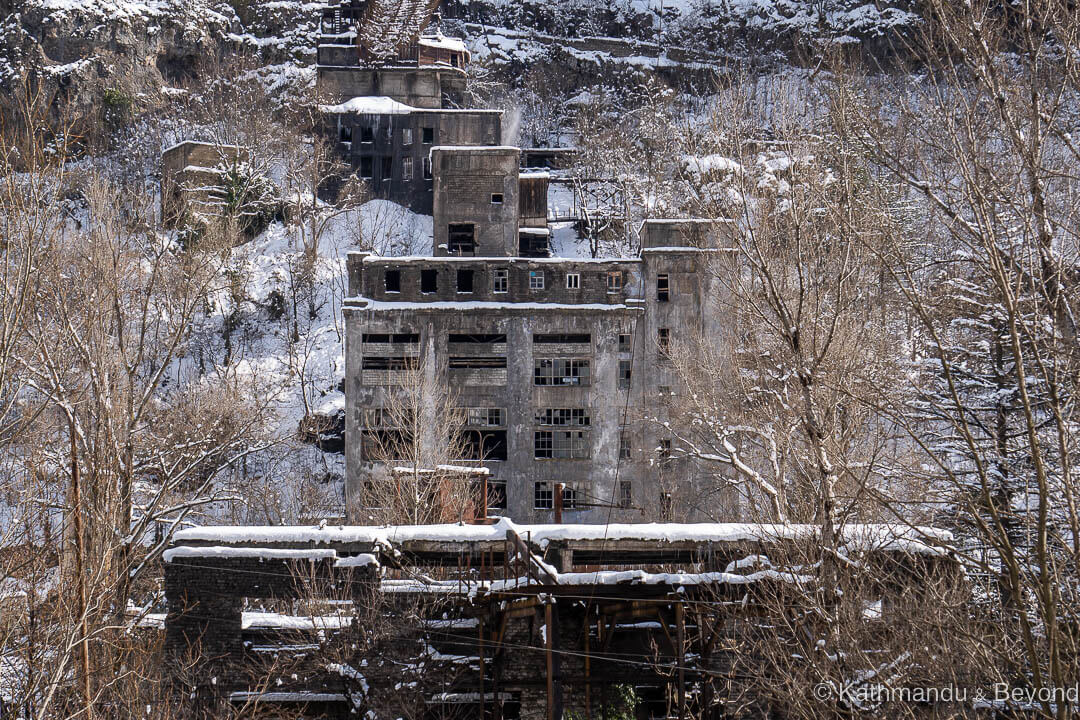
During the chaos and economic crisis that ensued in Georgia after the collapse of the Soviet Union in the early 1990s, the manganese mines in Chiatura ceased functioning for a period of time. As a result, many of the town’s folk left to seek employment elsewhere. A population of nearly 30,000 in 1989 is more like 12,800 these days (2021/22 censor). I can’t ascertain when exactly the mines opened again but, from what I can gather, they are either partially or fully operational once more and belong to a subsidiary of the British steel company, Stemcor.
Although Stalin died in 1953, his connection with the town and the miners from the time when he was a revolutionary led to the cable cars being dubbed ‘Stalin’s rope roads’ or ‘Stalin’s death coffins’. The terms ‘iron/death/flying’ coffins were also commonly used to describe them and were connected to the (lack of) maintenance that was associated with them before they stopped running. I’m sure the nicknames were also down to the fact that you tended to take your life into your own hands if you decided to ride in one!
Things to do in Chiatura
The locations for everything featured below are listed on this map.
Riding Chiatura’s new cable car system
The good news is that, as of September 2021, it has been possible once more to glide from one part of Chiatura to another in a cable car. Nostalgia for the old Soviet-era rust buckets aside, the even better news is that the French-designed and constructed aerial tramway system is new, modern, reliable and, above all, meets all the standard health & safety requirements associated with aerial tramways in, say, Western Europe for example.
Chiatura’s new cable car system comprises four lines (as opposed to the original one which had seventeen) that all depart from the Central Cable Car Station, which is centrally located on the southern bank of the Kvirila River. The Central Cable Car Station is also new and modern, as are the four stations attached to each of the lines which extend in different directions above the city.
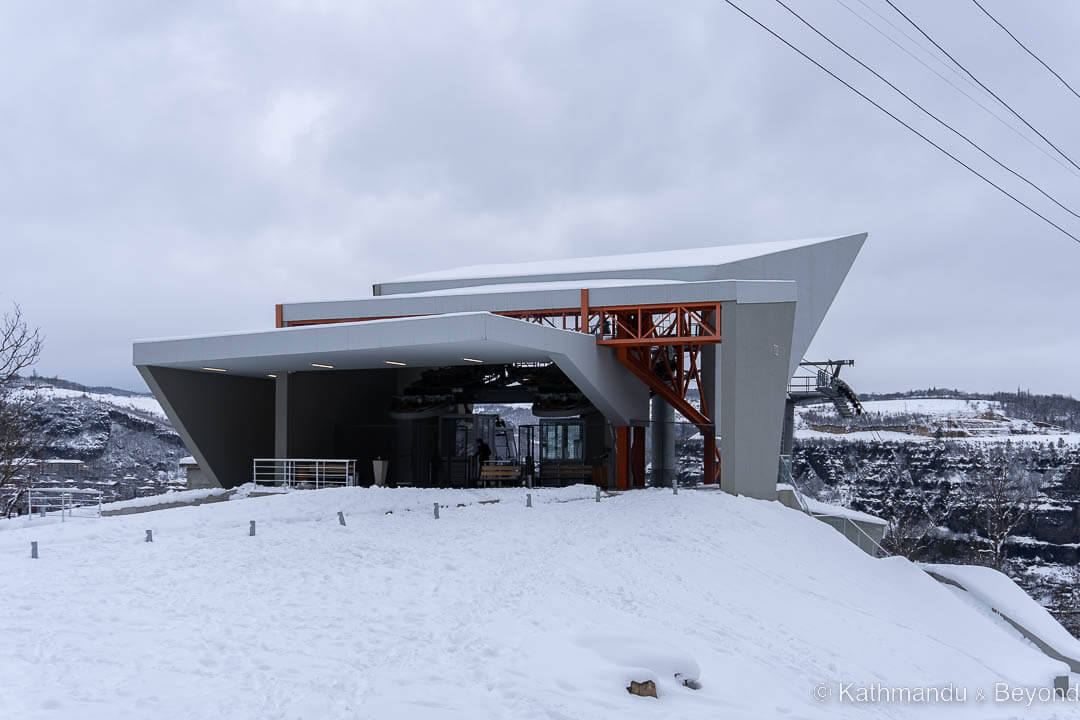
The lines are ‘Sanatorium’ (862 metres); ‘Naguti’ (1081 metres); ‘Lezhubani’ (845 metres) and ‘Mukhadze’ (640 metres)
The reverse-type gondolas are also high-tech. Seating eight-ten people, they offer a smooth and quiet ride at a reasonable speed.
Unlike the original cable car system, which was free, there is a nominal charge for riding the new one. Each ticket cost 50 tetri (0.50 GEL/£0.16/$0,18). It is possible to buy tickets in bulk at the Central Cable Car Station.
Although taking a ride on at least one of the new ropeways is an enjoyable and recommended experience, the best thing about them is the uninterrupted view you get from inside the gondolas. The old Soviet cars only had a handful of portholes and so you had to wait until you had reached the top before getting a decent view back down. Whereas, the new gondolas have floor-to-ceiling glass windows and you can enjoy some terrific vistas as you journey above the city. We went on all four lines and thought the best one for views was ‘Lezhubani’ as you pass Soviet-era apartment blocks at eye level and also look directly down on the former cable car station ‘Abashidze’. The ‘Mukhadze’ line is also interesting in that you pass over the railway station and accompanying tracks and sheds.
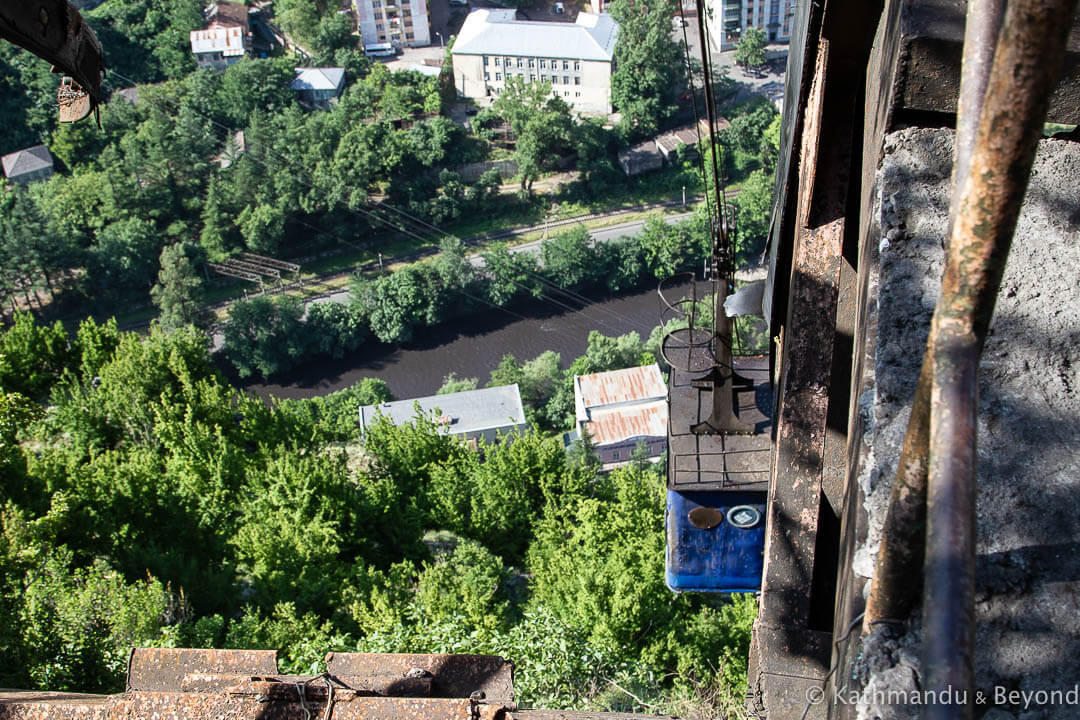
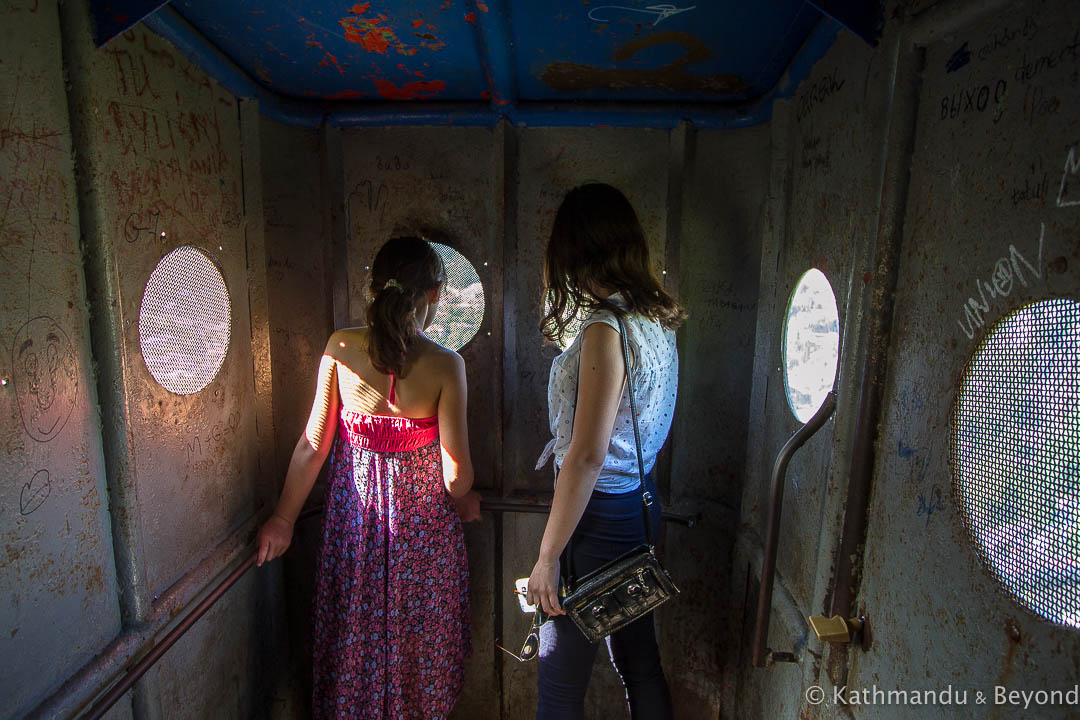
Old cable car stations and hanging cable cars
Even though the Soviet-era cable cars aren’t functioning, it is still worth wandering around the town and its outskirts looking for some of the former cable car stations. The architecture is mostly either Stalinist Empire style or Soviet Modernism. Some of the newer original stations were replaced when the new system was constructed but there is still a handful that can be seen. In town, former cable car stations ‘Chavchavadze’ and ‘Abashidze’ are worth searching out, while on the way to Temur Maghradze Stadium (see below) it is worth taking a look inside the remains of Cable Car Station ‘Tsedepe’. A short walk from the new ‘Mukhadze’ station is the original ‘Mukhadze’ station- look out for it as you journey up to best get your bearings.
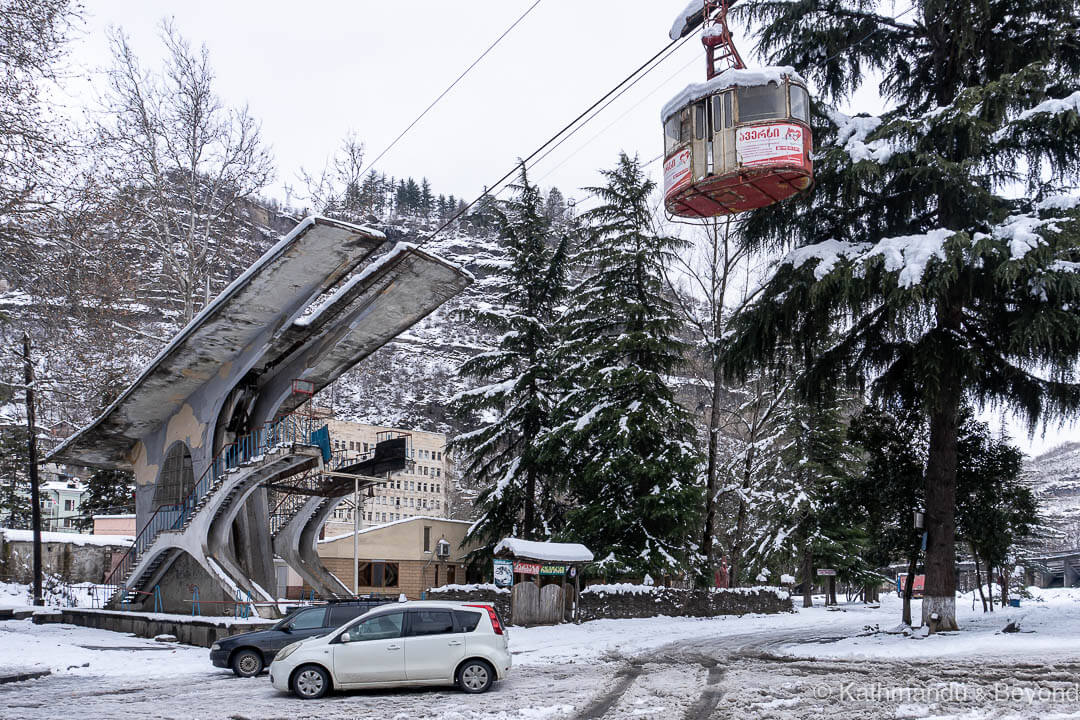
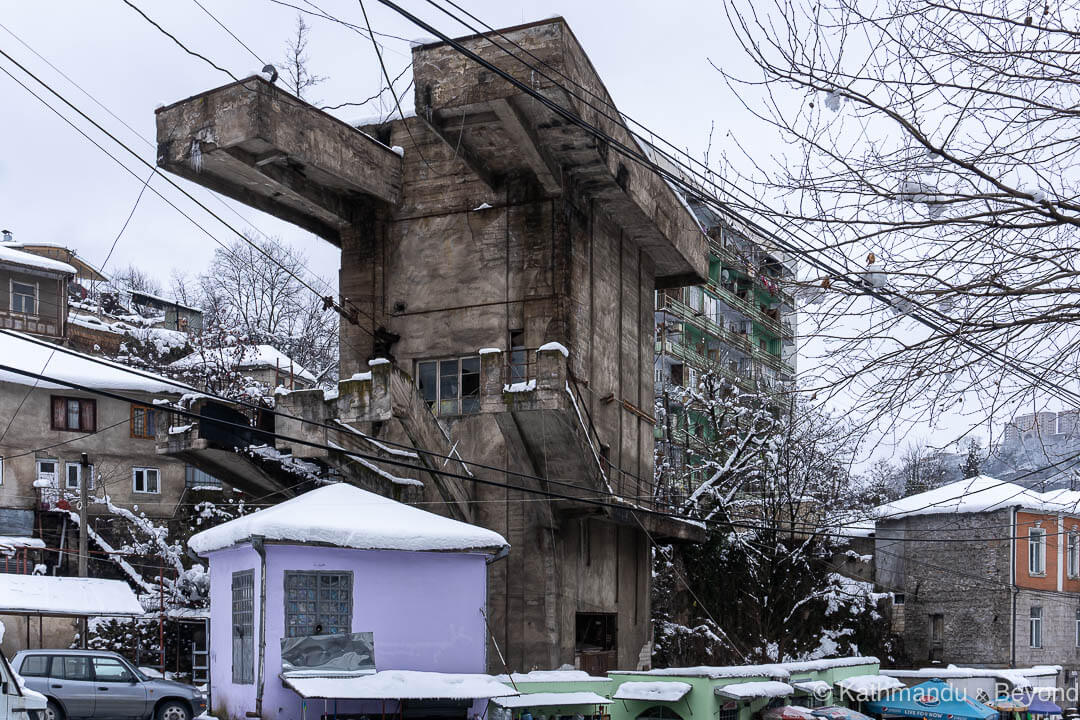
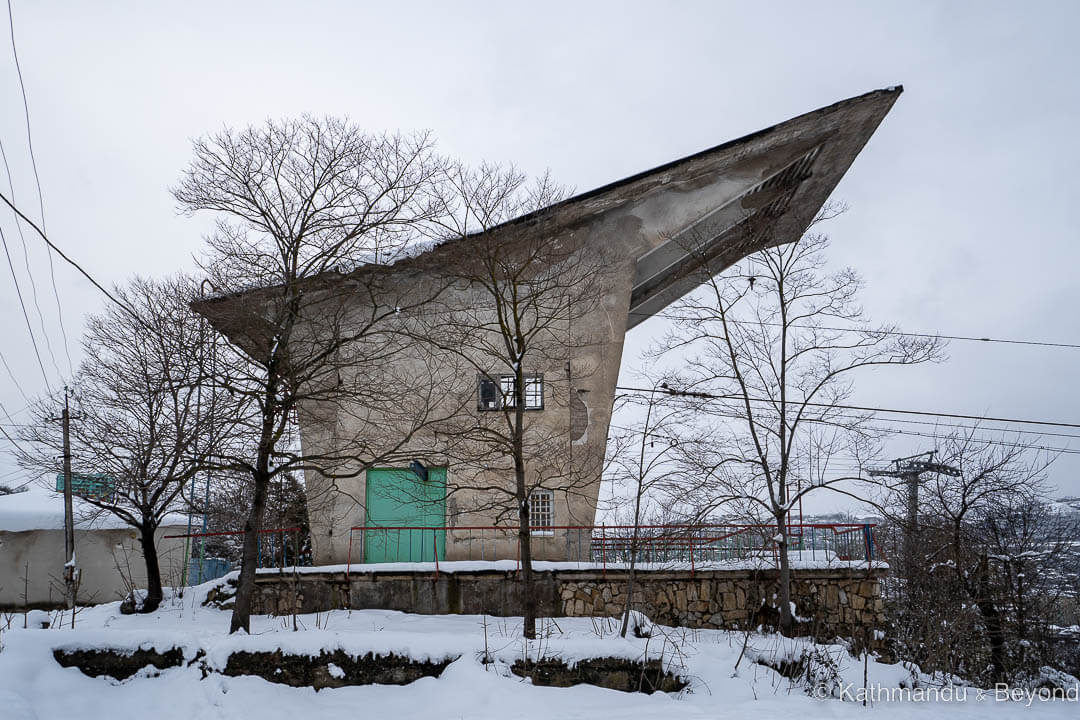
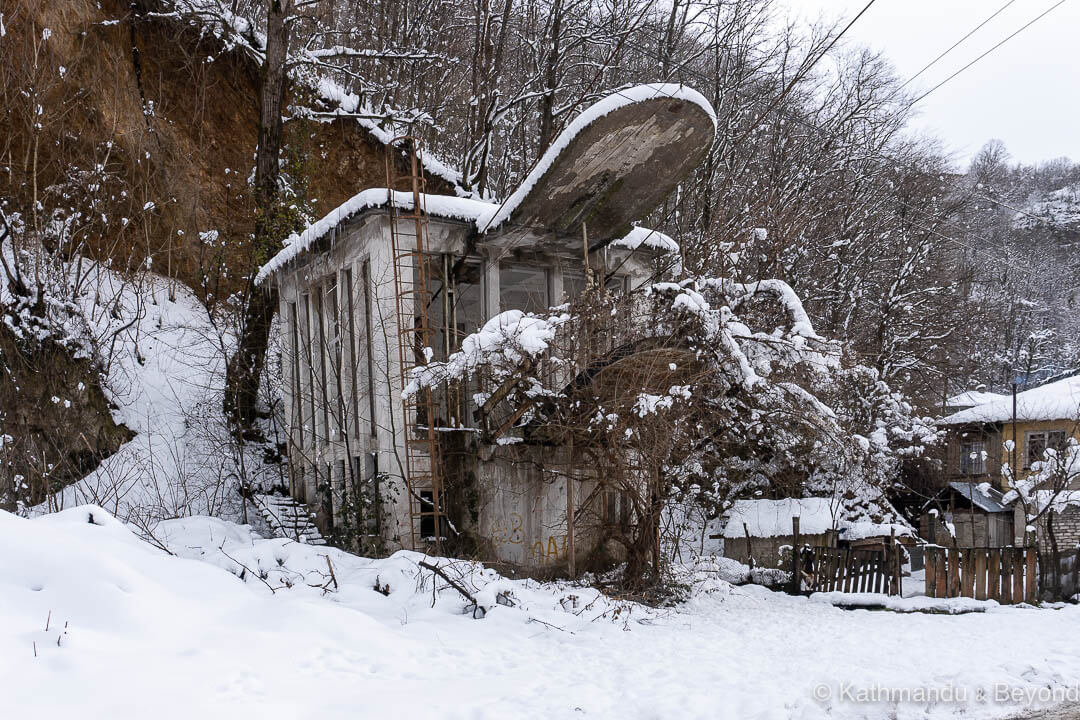
The remaining original Stalinist Empire-style cable car stations in Chiatura have been granted the status of a cultural heritage monument. The eventual aim is to restore the stations, and the ropeways attached to them, to their former glory and have them operating once more.
Work on Chiatura’s most impressive station from that era has already begun. Cable Car station ‘Chiatura-Perevisa’ (photo above) (*), was the first passenger ropeway to be constructed in the 1950s and is typical of Stalinist Empire-style architecture.
(*) Perevisa is a small village on the Chiatura Plateau, approximately 9kms south of Chiatura town.
During our first visit to Chiatura, it was possible to enter the station and inside was an old hanging cable car along with a piece of art depicting a pensive-looking miner. The art was created in 2015 by a prominent Georgian street art artist called Dr. Love. Among other places, his work can also be seen in Tbilisi and Batumi. The station was boarded up during our 2022 visit and it wasn’t possible to get inside. Presumably, when the renovation work has been completed, the station will be a prominent tourist attraction and access will be granted once more. I can’t find out if the artwork will be kept or not.
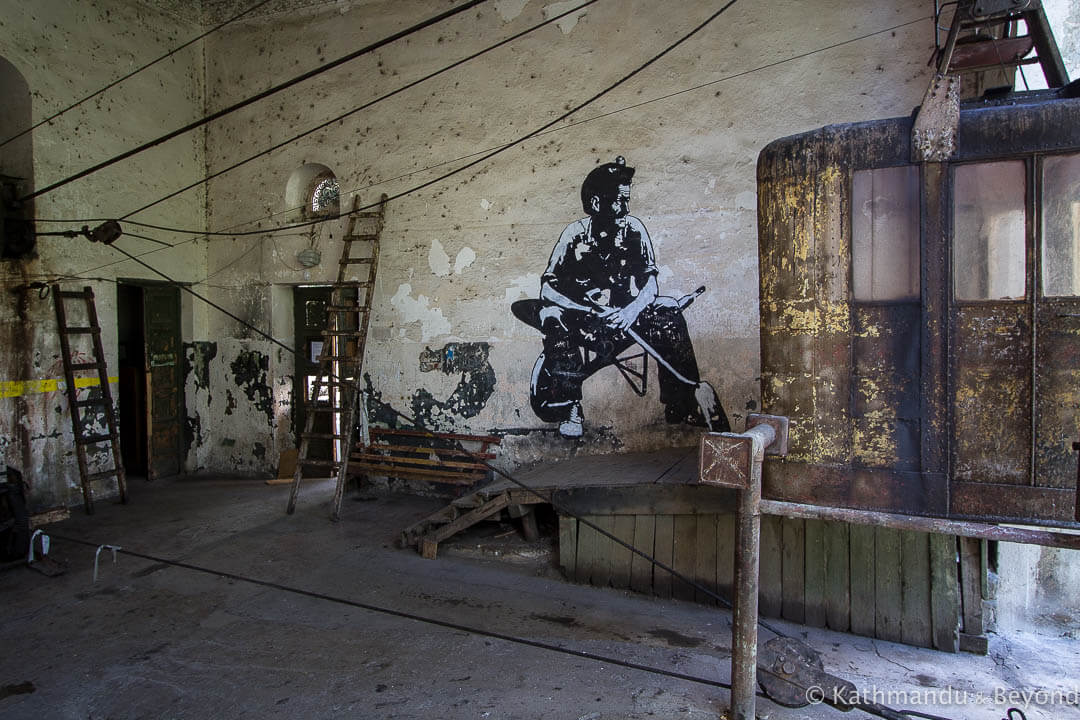
Hanging cable cars are not as prolific in Chiatura as they used to be but, there was a colourful red one dangling by the former Cable Car Station ‘Chavchavadze’, which is easy to view.
Chiatura Railway Station and adjoining depot
We always head away from the centre of a town or city wherever we are as you never know what you might stumble across. In the case of Chiatura, we were drawn to the road leading out in the direction of the railway depot. The station itself, which is no longer in use, was late Soviet in design but more interesting for us in this instance was watching the goings-on on the tracks. Freight, which was presumably manganese or a form thereof, was being shunted from one area of the depot to another with reasonable regularity and we stopped for quite a while and watched all the happenings. The employees didn’t seem to mind us hanging around and we got a honk and wave from the crews of ageing locomotives on more than one occasion.
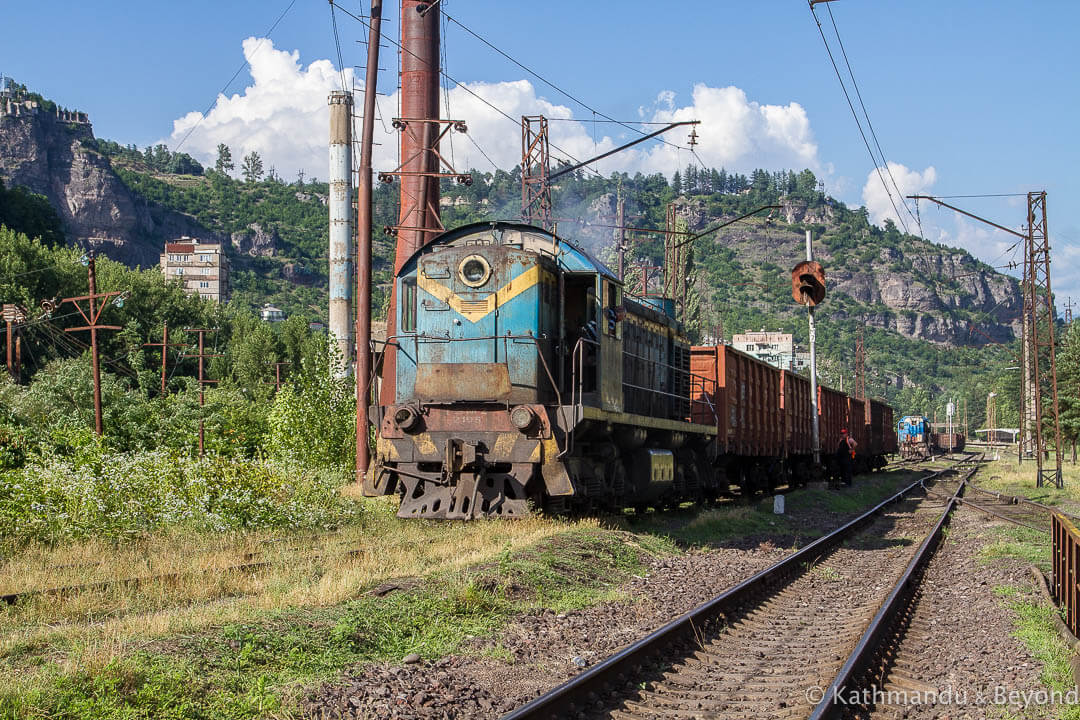
Temur Maghradze Stadium
When we were done watching life at the railway depot, we continued southwest along the same road past the abandoned Cable Car Station ‘Tsedepe’ to Temur Maghradze Stadium. At first glance, we presumed that the town’s football stadium was also abandoned. But, on closer inspection, we noticed that the pitch was cared for even if the stands were not and after we’d come back from exploring the wooden underneath of one of the stands, we were greeted by a bunch of guys playing football.
I found out later that this dilapidated stadium dates back to the mid-1960s and had a capacity for nearly 12,000 spectators when it was originally built. It’s in such poor condition because it was affected by an earthquake that struck Georgia on 29th April 1991. Recording a magnitude of up to 7.0 on the Richter scale, Chiatura, along with other towns and villages in the area, was one of the worst affected places and recorded the highest number of deaths (270) in that vicinity. In the aftermath of the quake, fixing the stadium was a low priority compared to other damaged structures in the town and, from what we could see, apart from the pitch, it still is.
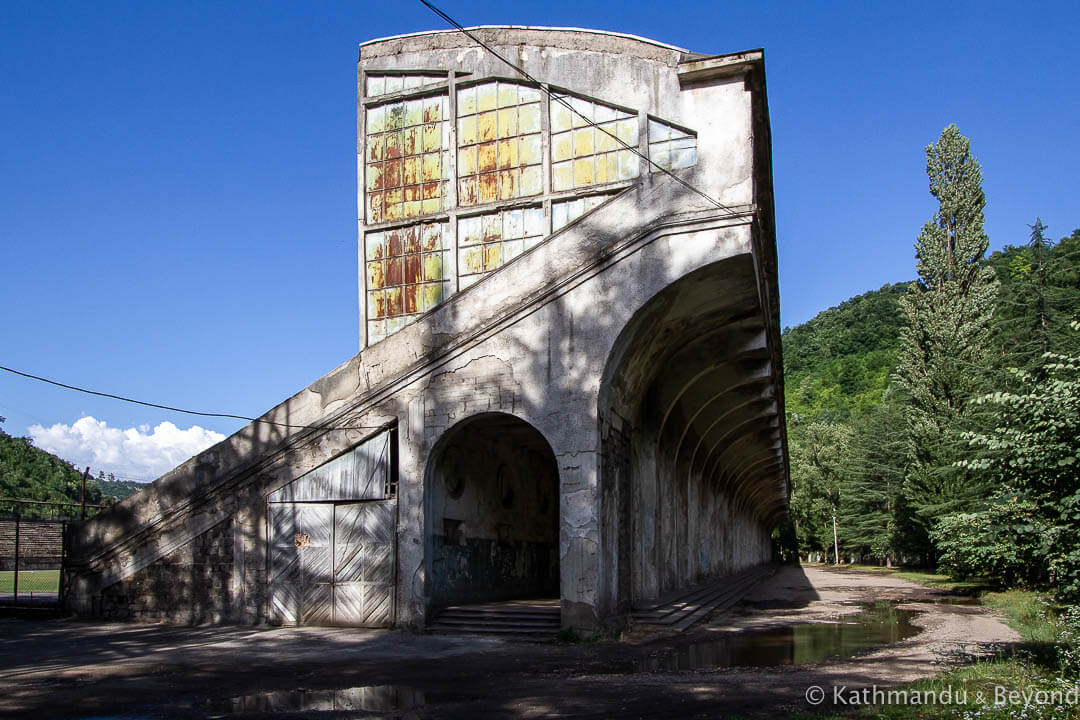
To the left of the stadium are two more buildings, one housing a gymnasium/basketball hall and the other an indoor swimming pool. Both are still in use. We found little of interest inside the gymnasium/basketball hall but not so inside the indoor swimming pool, which was decorated with two marvellous Soviet-era mosaics, one at either end. Although both mosaics were in excellent condition, the one at the shallow end of the pool was the most impressive. It depicts a sea scene and is likely a reference to Jason and Argonauts because of the inclusion of the Argo (mythological ship) in the centre of the piece.
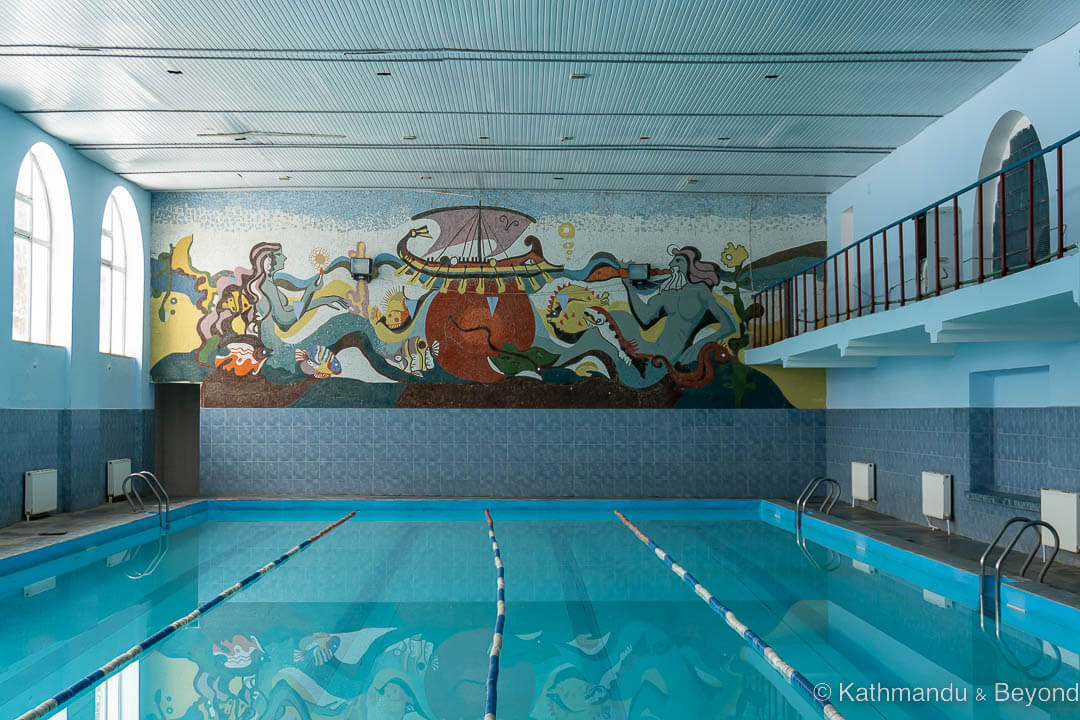
To see the mosaics in person, it is best to enter the swimming pool’s reception, smile at whoever is there (in our case it was an elderly caretaker) and ask nicely to see the ‘mosaika’. We were welcomed in and know of other foreign travellers who have also been permitted to enter. The pool was empty during our visit and so I can’t vouch for how easy access would be if it was being used.
Other mosaics and Soviet-era artwork
As well as the mosaic inside the swimming pool at Temur Maghradze Stadium, we also found three other centrally-located mosaics created during Georgia’s Soviet period. The most impressive was a large panel on the side of the Metallurgy-Mining Institute. Of the other two, one is on the side of a public school and features the famous Georgian poet, Shota Rustaveli, while the other one, which is nicer and worth the effort of climbing up a steep road to see, decorates the wall of a kindergarten.
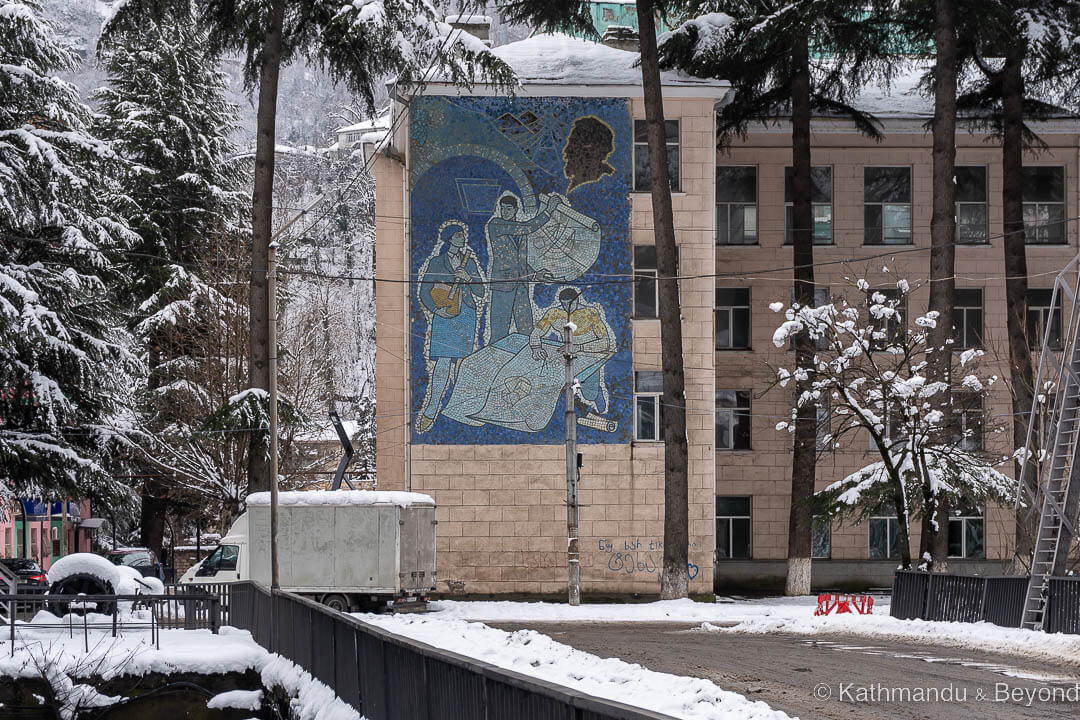
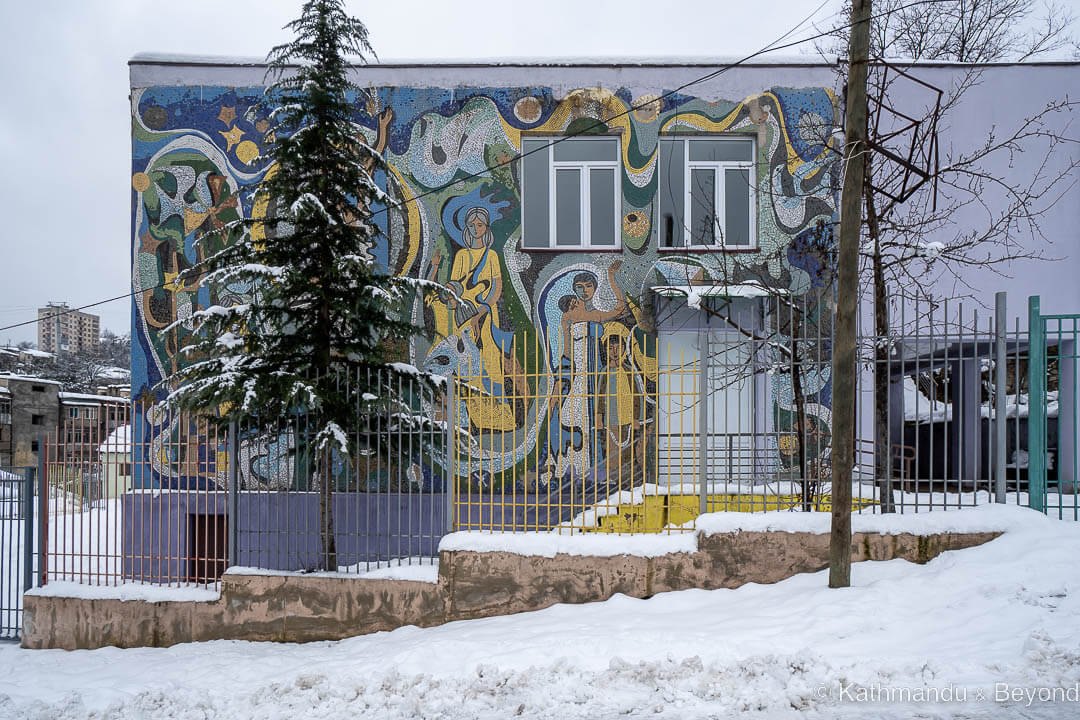
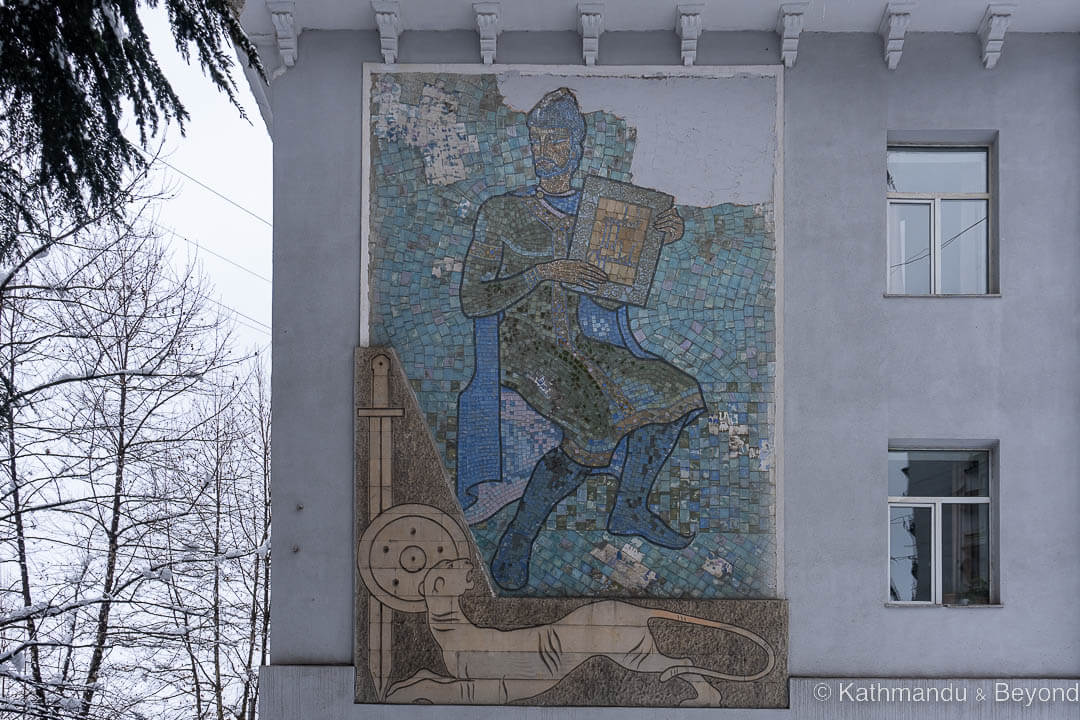
Around 450 metres east of the Hotel Newland there is a very decorative piece of relief above and to the side of the main entrance to the Hotel Nikoli which has some great detail and predominately depicts miners.

Soviet-era architecture
Like the cable car stations, other architecture in Chiatura is a mixture of Stalinist style and Soviet Modernism. The town is not brimming with what I would call striking examples of either genre but there is enough to warrant a stroll around town if either style interests you.
Notable buildings to look out for whilst wandering around include Chiatura City Hall. The building backs onto the Qvirila River and is a good example of modern Soviet architecture. Opposite the city hall is the interesting facade of the town’s central market and if you keep following the course of the river in a westerly direction, you’ll spot an overhanging modern Soviet building that looks like it used to be a restaurant but is no longer in use. Shopping Centre ‘Globe’, which is near the town’s bus station, is another decent example of Soviet Modernism.
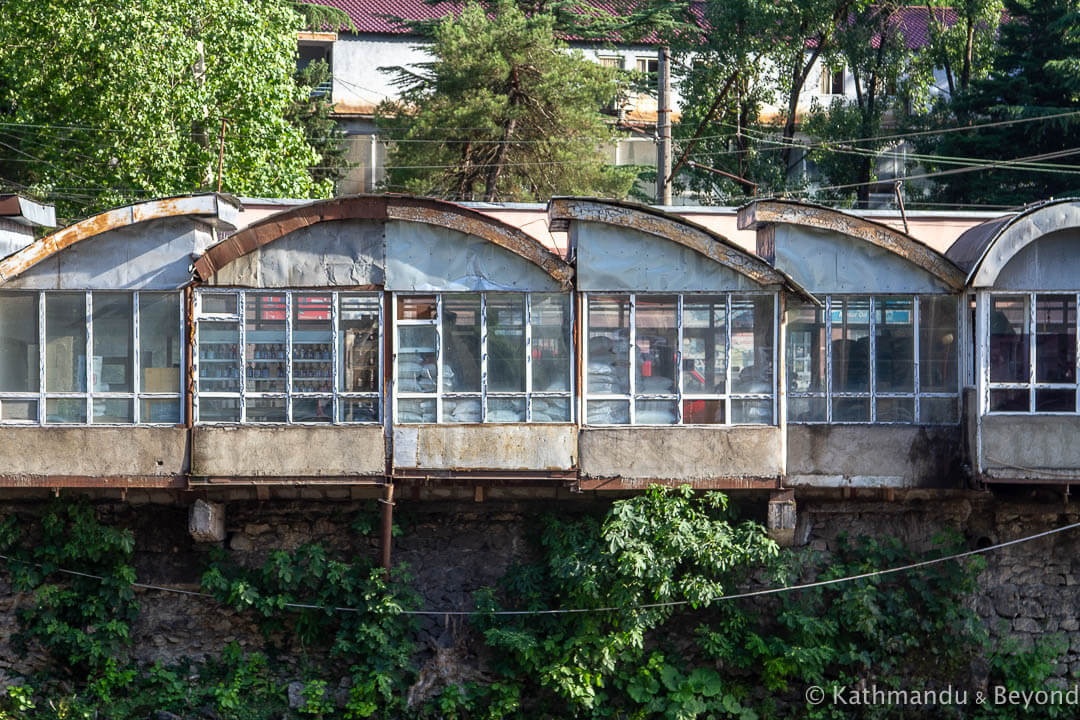
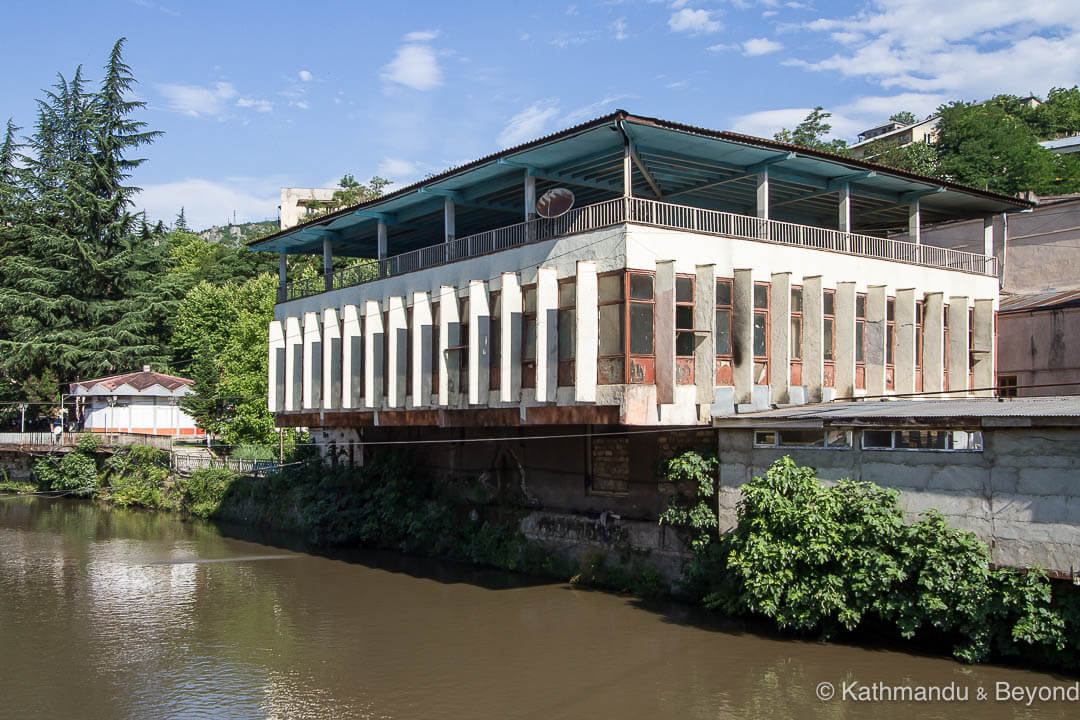
One of the nicest structures we spotted was the Palace of Culture/community centre. Although not ornately decorated, the building is a good example of Stalinist architecture and one of the town’s grandest buildings.
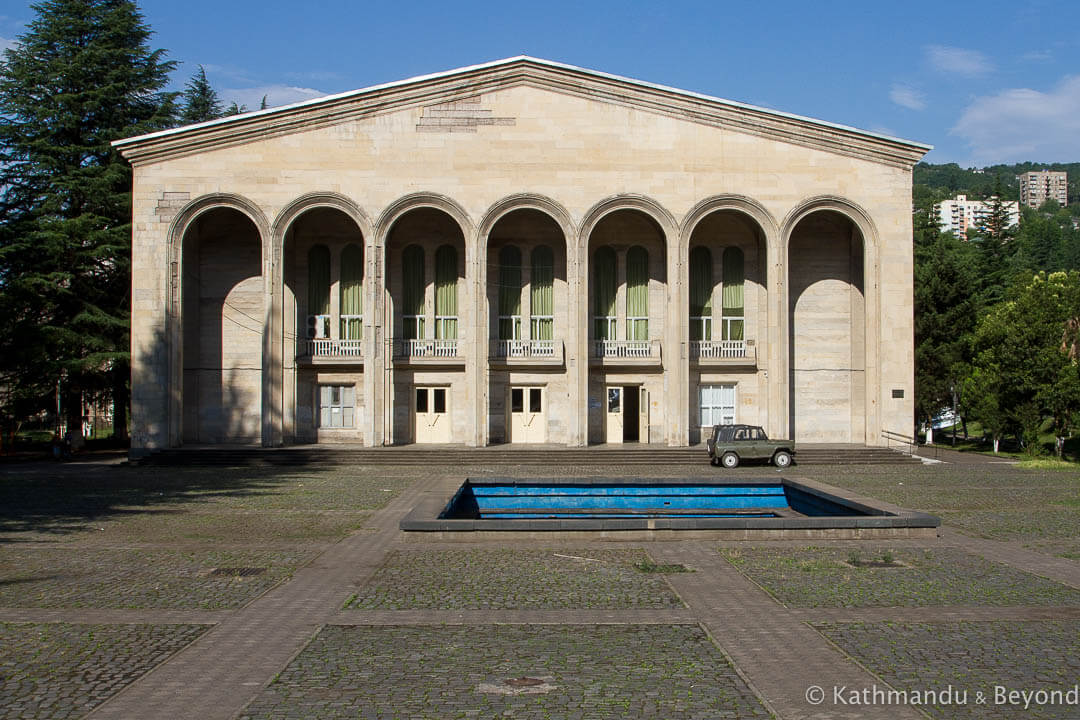
There are also a high proportion of Soviet-era concrete-panelled apartment buildings in Chiatura. Often referred to as Khrushchyovka because this type of low-cost housing was advanced when Nikita Khrushchev was in charge of the USSR (1953-1964), they are easy to spot, especially if you ride the cable car system.
A couple of apartment buildings that caught our eye, along with the architecture mentioned above, are marked on the map.
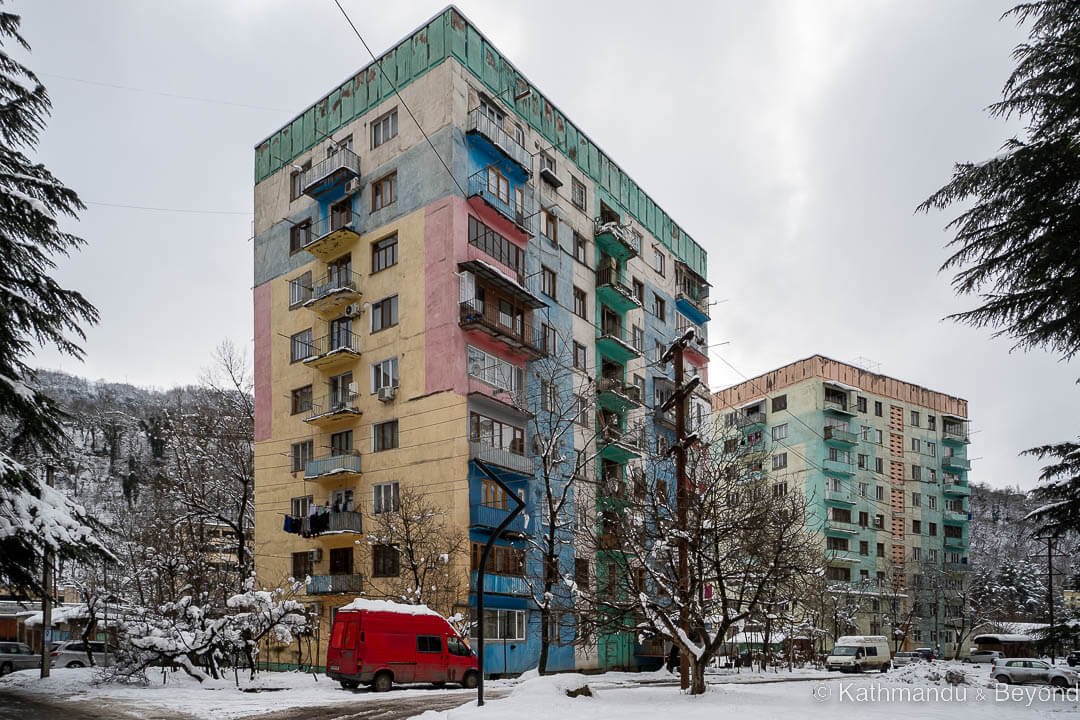
Monuments and memorials
You can’t miss Chiatura’s impressive Monument to the Great Patriotic War (World War II) if you are coming into Chiatura on the road from Zestafoni. It is situated on a grassy verge on the left-hand side near an apartment building and just before the road leads sharply down to the town itself. Because we spotted the memorial on the way into Chiatura, we didn’t have the option to stop and take a closer look but when we left the following day, we simply took a local bus up to where it was located, took our photos and then waited on the side of the road for a passing marshrutka (fixed route minivan) to continue the journey, which, in our case, was on to Kutaisi.
Alternatively, Cable Car Station ‘Naguti’ will get you within a 15-minute walk of the monument.
There is a wall-mounted monument dedicated to Shota Rustaveli in Chiatura. It is located across the street from the Hotel Newland.
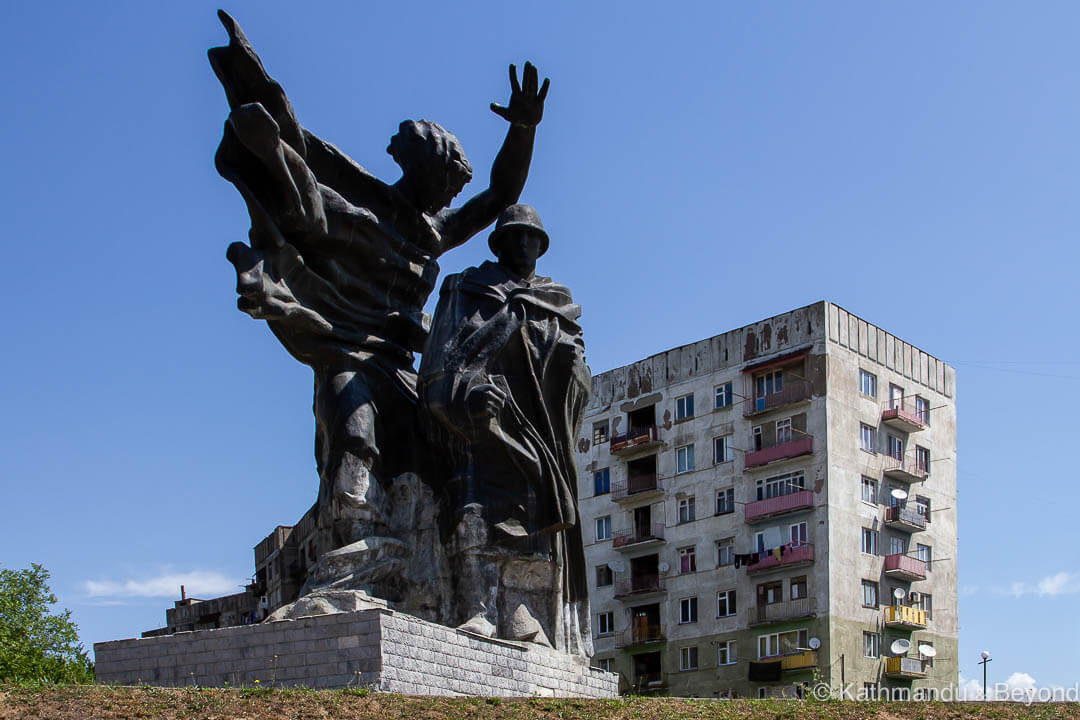
Former Pioneer Palace
Besides riding in one of the original cable cars, our other primary reason for going to Chiatura in 2018 was to visit the town’s now-abandoned palace for young pioneers.
Young Pioneers are akin to the Scout movement in the West, albeit with a bit of political ideology thrown in for good measure, and Pioneer Palaces were the Soviet equivalent of summer camps. The one on the outskirts of Chiatura was established in 1960 and remained in use until 1997.
The 1991 earthquake combined with the break-up of the Soviet Union were the reasons why the palace stopped functioning and how it became to be in such a dreadful state of repair. In fact, it is probably one of the most dilapidated structures we have ever been inside and clambering up to the second level to get a decent shot of the building’s last remaining piece of Socialist realism-style artwork isn’t something I’d care to repeat any time soon (*).
(*) It was getting down the once-sweeping but now non-existent staircase that was the issue rather than the going up!
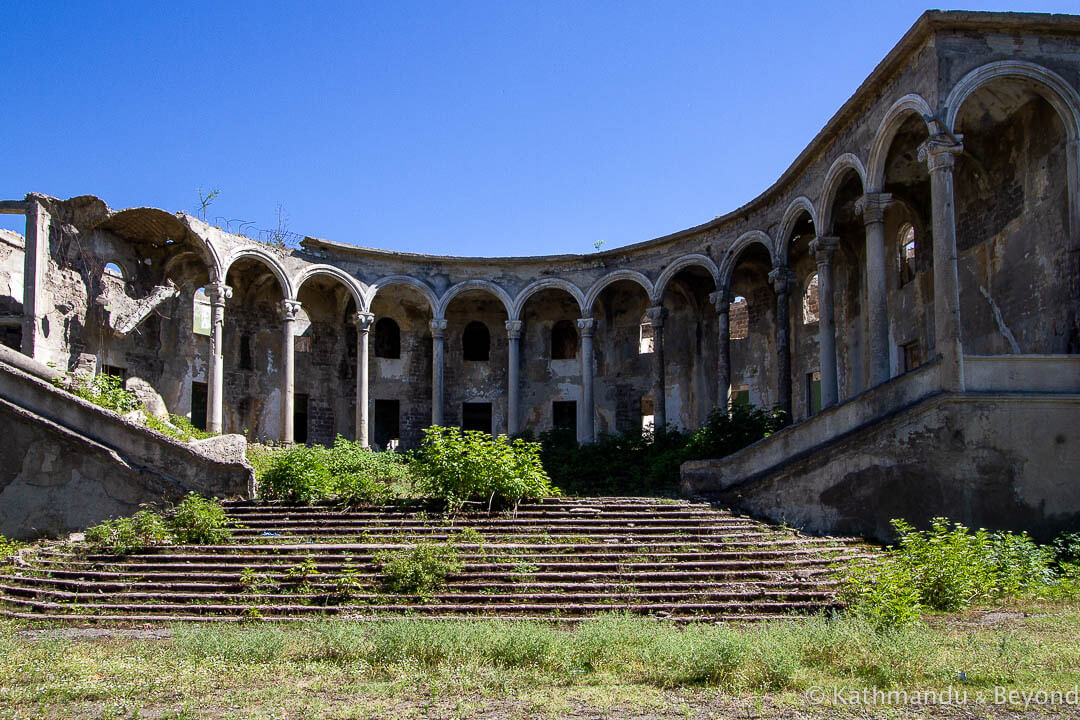
As we explain in this more detailed post about the Pioneer Palace in Chiatura, its fate is in the balance. More than one restoration plan has been proposed in recent years to try and save the place from completely crumbling to the ground. What remains of the edifice is protected as a national heritage monument so it shouldn’t be purposely demolished. But, in July 2021, work began on the development of a recreational area in the immediate vicinity of the building which already features a Ferris wheel and a merry-go-round. There are also rumours that what’s left of the structure will be knocked down in order to build something else on the plot.
Hence, the pioneer palace may or may not be there in the future. If you visit, please let us know of any developments so we can update the post – thank you.
The most convenient way to reach the grounds of the pioneer palace is to take a cable car from the Central Cable Car Station to ‘Sanatorium’. From there it is a 150 metres/2-minute walk to the location.
Chiatura Cross
Without your own transport, getting to this large hilltop cross involves either a nasty uphill hike or a round-the-houses taxi ride. The view would be the main draw if you do decide to give it a go.
Places worth visiting near Chiatura
Sachkhere
Sachkhere is a small, scrappy town 15kms northeast of Chiatura. The primary reason to visit Sachkhere is to see its marvellous, and recently renovated, turn-of-the-20th-century railway station. But, if you have your own transport, or don’t mind hopping off a marshrutka in the middle of nowhere and then walking a bit, there are two magnificent pieces of artwork on the outskirts of town that will make you giddy with excitement if Soviet-era mosaics and tile art are your thing.
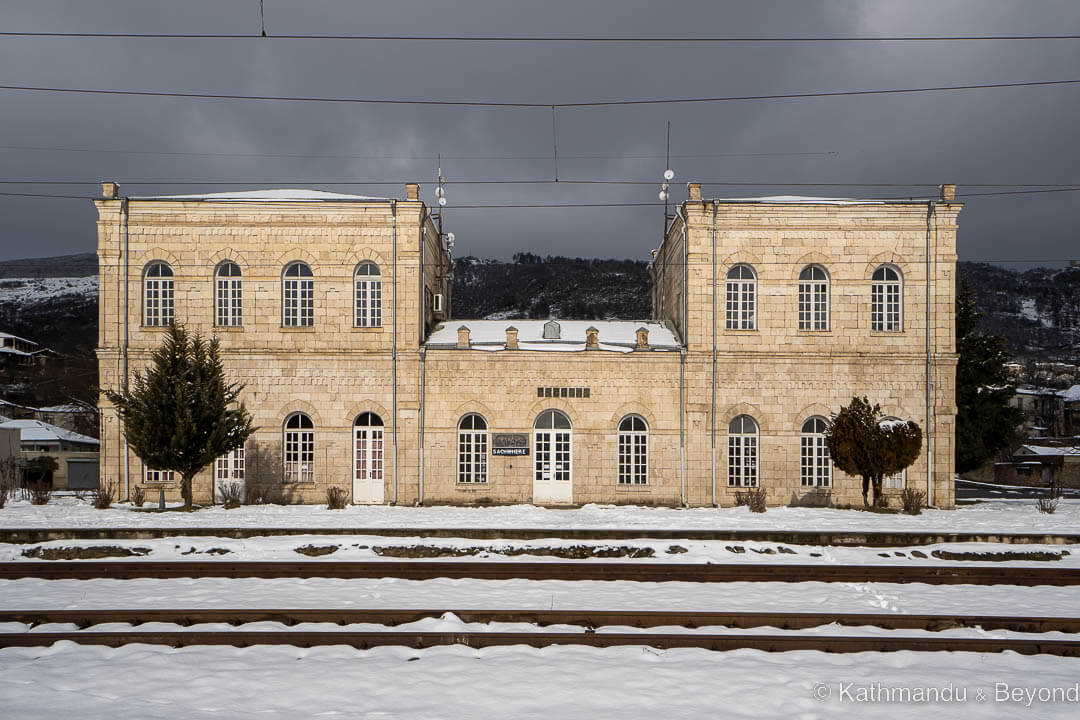
The first of these is a former gas station, which is almost entirely covered in a transport-themed mosaic, and the other is a former cotton processing factory which features a large piece of tiled panel art on its side wall. The gas station is no longer in use, whereas the factory now functions as a timber yard. So, with the latter, we approached and asked permission to enter to take some photos.
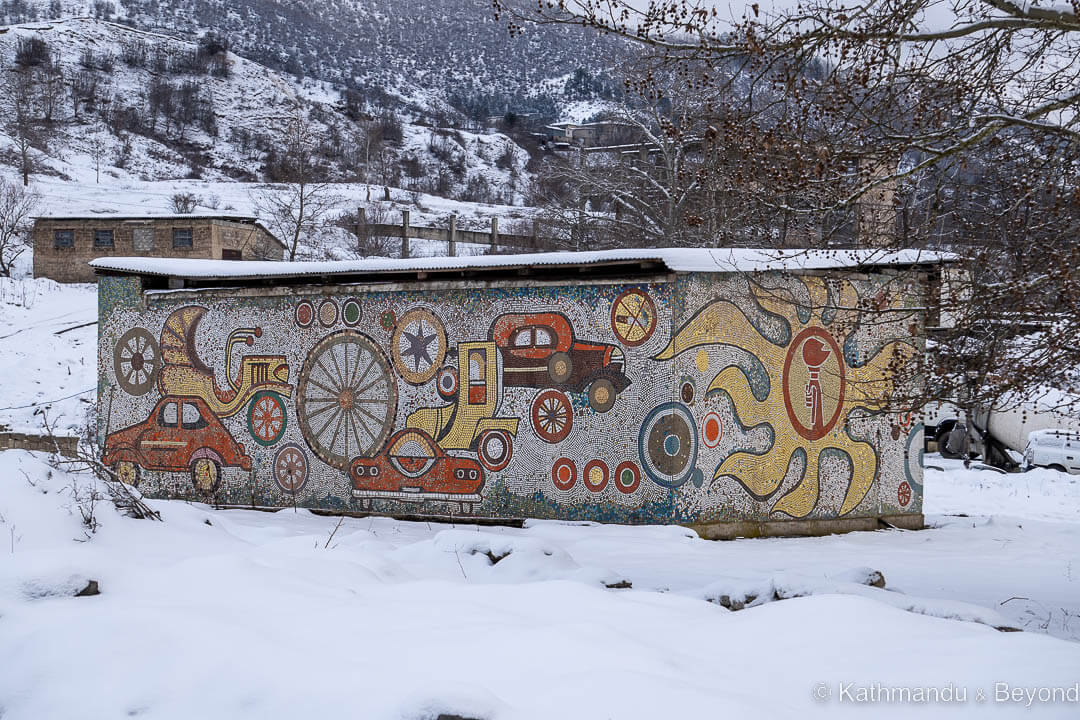
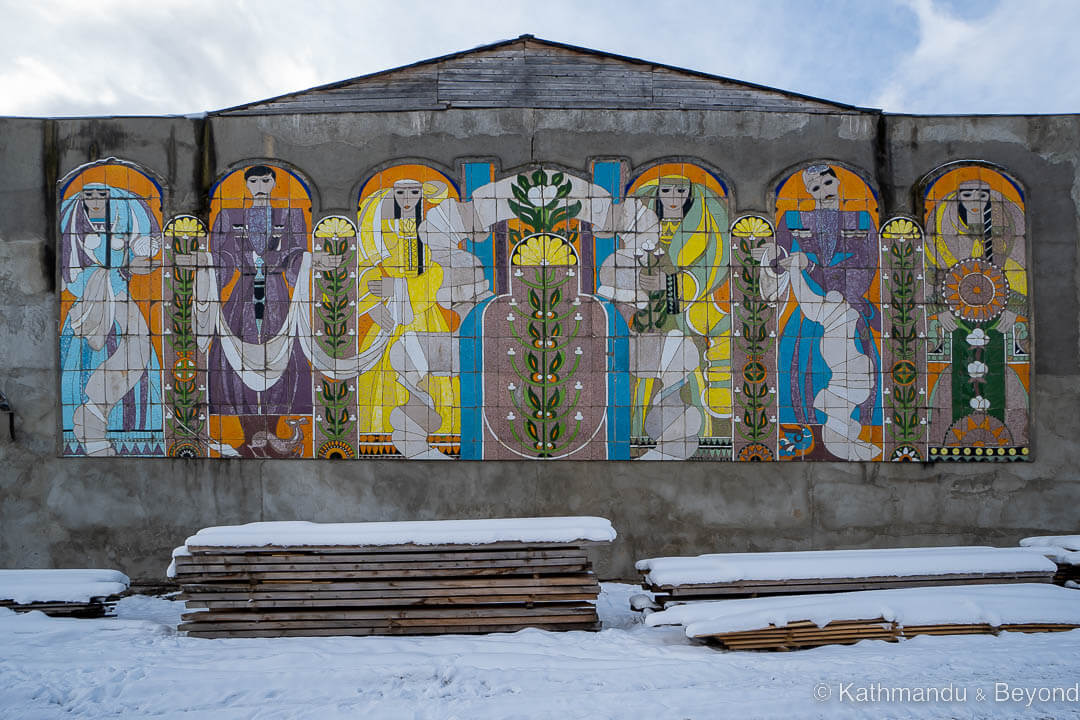
If you are inspired to visit these places using public transport, this is how we did it;
Stage 1; Take one of the frequent marshrutkas from downtown Chiatura (they also pass the Woodland Hotel) in the direction of Sachkhere for 11kms. At this point, you will see the gas station on your left (GPS: 42.33045, 43.38337). Shout to the driver, who will no doubt be perplexed (as will his passengers) to be let off at this point.
Stage 2; As the crow flies, it is only around 500 metres from the gas station to the former cotton processing factory (GPS: 42.32934, 43.38917). Under normal circumstances you might be able to cut across country but, with heavy snow on the ground, we had no option but to walk along the road until we reached a main turn-off (GPS: 42.334235, 43.395134) and then backtrack to the factory. This was a distance of around 2kms.
Stage 3; Then walk 1.2kms to Sachkhere railway station (GPS: 42.33516, 43.39925). Alternatively, take the slightly longer route via the centre of Sachkhere if you want to have a quick look around, which is what we did. Another option if you can find a cross-country route from the gas station to the former cotton processing factory would be to retrace your steps and wait for a marshrutka to take you into Sachkhere.
Stage 4; All marshrutkas pass by the train station en route to Chiatura so flag one down from there to get back.
Katshki Pillar
Located 6kms west of Chiatura as the crow flies, and 12kms by road, Katshki Pillar is a 40-metre-high limestone monolith with a small monastery on top. Shrouded in myths and legends and referred to as the ‘Pillar of Life’, it is believed that the rock was originally used as a medieval hermitage and dates back to the 9th or 10th century. The current church is dedicated to the Christian monk, Maximus the Confessor, and besides the house of prayer, the small complex also consists of a burial vault, three hermit cells and a wine cellar (priorities!).
Since 1995, the monolith has been occupied by a lone monk called Father Maxim Qavtaradze. A native of Chiatura, with the help of locals and money collected from donations, he has worked on restoring the elevated monastic buildings and also installed an exterior iron ladder running from the base to the top, which begs the question, how on earth did his predecessors managed to get up and down the vertical rock face?
Previously, male, but not female, visitors were permitted to visit the monastery using the ladder mentioned above but this practice has now been stopped (which is probably a wise move!) and, as a member of the public, it is only possible to wander around the base of the rock and look around the small church that has been constructed nearby.
You get a decent (distant) view of Katshki Pillar when travelling along the Zestafoni to Chiatura road but it will only be a fleeting one if you are not in your own transport and unable to stop. If you want to visit the area in more depth then take any marshrutka that travels along that road, which will include any going in either the direction of Tbilisi or Kutaisi, and ask the driver to let you off at the turnoff for Katshki Pillar. From this point, it is about a 1.5km walk to the cloister itself. Keep in mind you will probably be asked to pay the full (end destination) fare on both journeys as this is common practice in this part of the world.
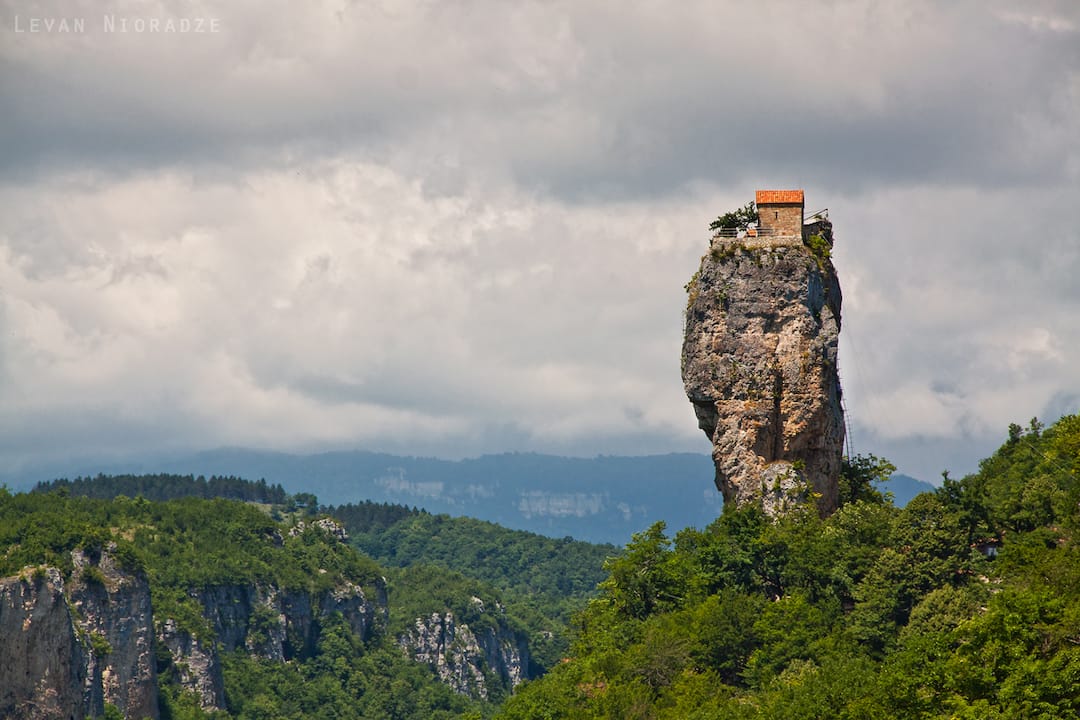
Where to stay in Chiatura
There are very few hotel options in Chiatura and if you want to stay as central as possible, you’ll probably have to pick between the Hotel Imereti and the Hotel Newland. They are next door to each other and there’s not much to choose between them. We stayed at the Newland and paid 60 lari for a double room with private bathroom. As our second stay was in the depths of winter, we were relieved to discover that our room was extremely well-heated, even though the public areas were not. The excellent restaurant at Newland was closed during our winter visit. A little further out of town, Hotel on Pirosmani is one of the cheapest Chiatura guesthouses. The choice of Chiatura hotels and guesthouses is growing and you can check all the options here.
How to get to Chiatura by public transport
To reach Chiatura by public transport from anywhere, you’ll need to take a marshrutka as follows:
Kutaisi to Chiatura
There are several marshrukta each day departing from Kutaisi’s main bus station. The times can be found on Visit Kutaisi’s website and are: 07:20, 08:20, 09:20, 09:45, 10:45, 11:45, 12:45, 14:00, 15:00, 16:00, 16:30 and 17:00. The fare should be 6 lari each way. The journey time is in the region of 1.5 to 2 hours.
Tbilisi to Chiatura
Marshrutkas to Chiatura depart from Tbilisi’s Didube Bus Station. They may not be that frequent so if you travelling to Chiatura from Tbilisi, you might find it easier to first travel to Zestafoni and take another marshrutka on to Chiatura. You’ll more than likely be picking up one coming through from Kutaisi but if you tell your Zestafoni-bound driver your ultimate destination, chances are he/she (most likely he) will help you with the connection. The journey time is in the region of 3.5 to 4 hours.
Borjomi to Chiatura
Although it’s not exactly the most direct route, it is possible to travel between Chiatura and Borjomi by taking a series of marshrutkas. We did this and first took one from Borjomi to Khashuri, another from Khashuri to Zestafoni and a final one to Chiatura. The journey time is in the region of 2.5 to 3 hours.
Should you visit Chiatura as a day trip or on an overnight excursion?
If you’re wondering whether to visit Chiatura as a day trip, our advice would be that whilst a day trip is feasible from Kutaisi, from anywhere further afield, including Tbilisi, it’s too much travelling. This assumes you’re travelling by public transport – by private car it would be manageable. Frequent marshrutkas make a day trip to Chiatura from Kutaisi quite straightforward although we recommend an early start as the last one back leaves Chiatura at around 5pm.
We hope we’ve answered the question ‘is Chiatura still worth visiting if the cable cars aren’t operating?’ and have encouraged you to include Chiatura on your Georgia itinerary.
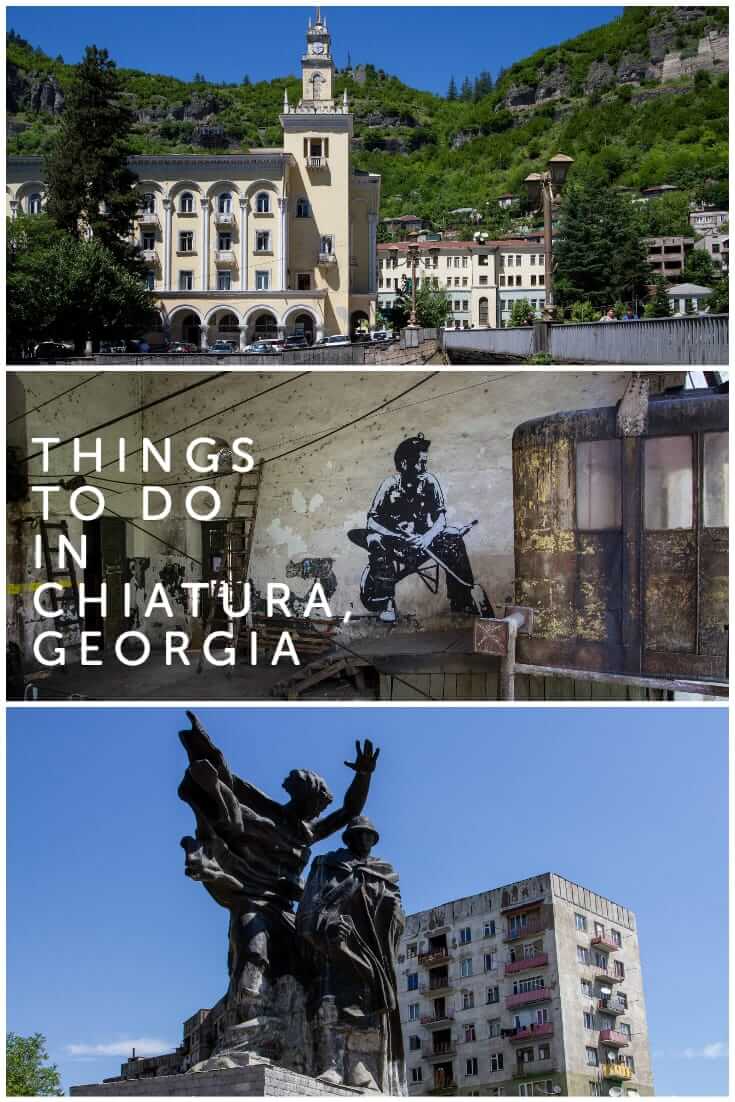
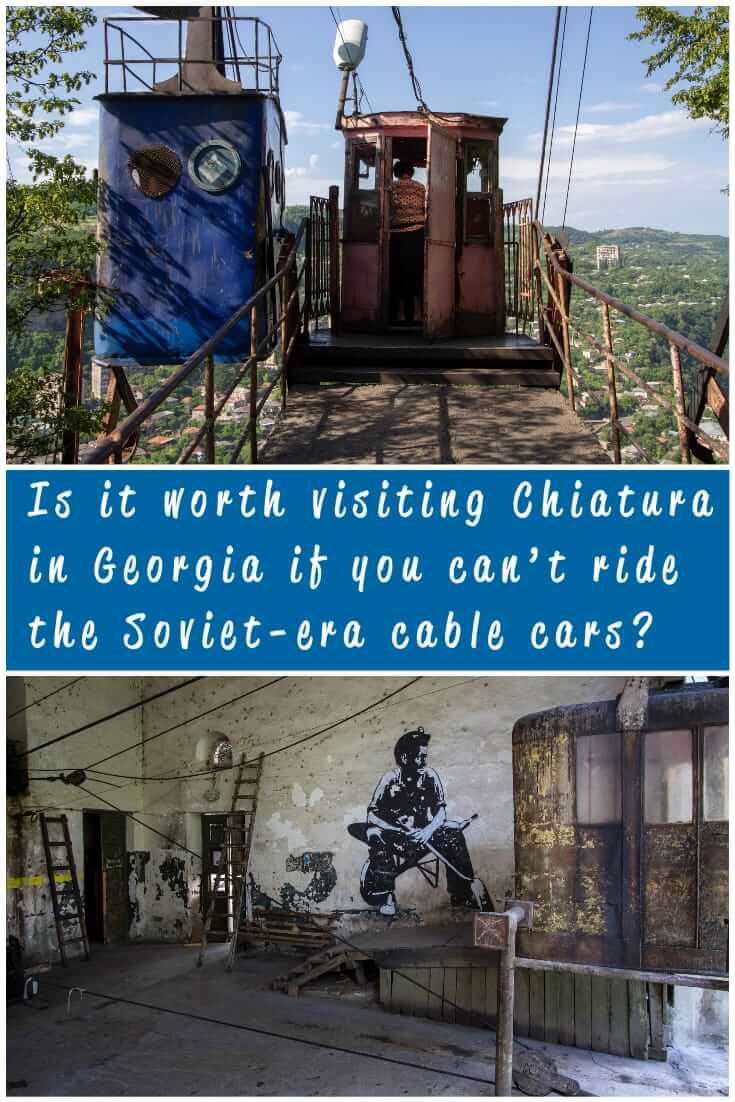
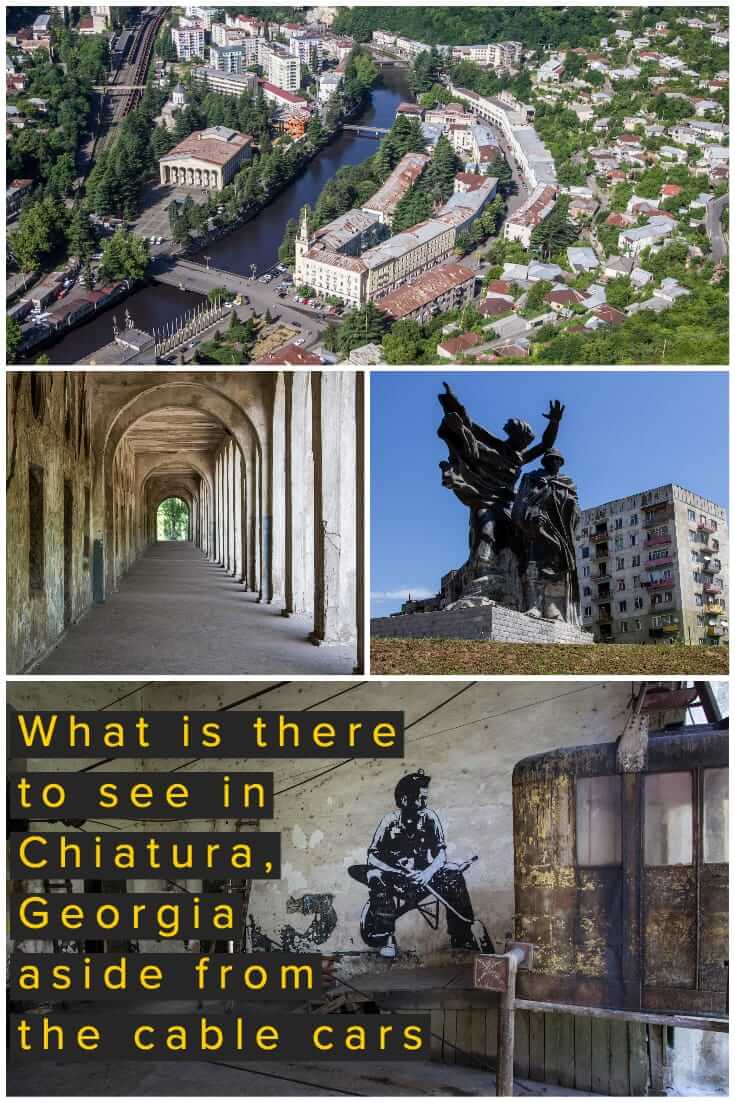

Great guide, I’m heading back next month and still have a lot to see!
Surely that’s Rustaveli on the plaque?
Of course, it has to be Rustaveli! We should have recognised him from his distinctive hat if nothing else! Thank you for the heads up 🙂
Looking forward to hearing what you think of the newly renovated cable car system. And a million apologies for the delayed reply – it’s that pesky spam folder that was to blame again!
i visited the pioneer palace in mid august of this year and it was still intact. however the area around it was a construction site, i had to ask for permission to go in and take a few photos. when i asked them about the palace, they said it would be demolished in two months.
Thanks for the update, Tristan. We had the same experience in February 2022 but were told we could not get close to the palace itself. It sounds like it hasn’t got long for this world.